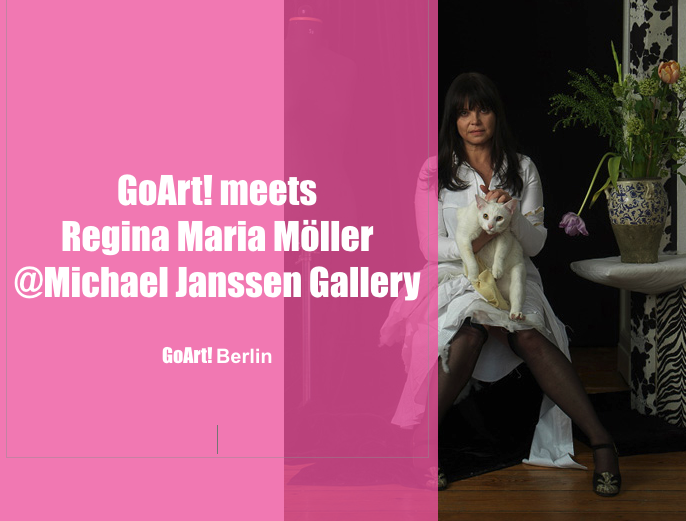Regina Maria Möllers’ exhibition ‚The Moth’ runs until November 17, 2018 at Janssen Gallery Berlin. Born in Munich Möller firstly took up her studies at the Philosophical Faculty of Ludwig Maximilians University. She spent a large part of her career as a professor/visiting professor as well as artist (since 1993) amongst others in New York, Stockholm, at the NTNU Trondheim, Singapore as well as MIT in Cambridge. Today she lives in Berlin. With ongoing and often interdisciplinary projects such as ‚regina’ or ‚embodiment’ Möller focuses on socially relevant topics that partly autobiographical. She consistently works at the interface between culture and everyday life.
GoArt! meets Regina Maria Möller.
MB: Regina, how does your day start?
RMM: When I am in Berlin I usually go to the SSE – I swim.
MB: At first glance, the gallery showcase is covered with a heavy black curtain. Entering the front space the visitor is confronted with a stage-like set of historical theatre curtains. Only after passing through does he reach the props warehouse, which is in the backspace of the gallery, exhibiting more of your works. Consequently, it becomes an indirect stage direction for the viewer – what role does the moth play in this production?
RMM: During the exhibition visitors pass the gallery through the main curtain and thus become participants. There is a shadow play in the center of the “stage” and by moving the curtains it reveals a new perspective to the viewer. Dramaturgy and orientation move circular – similar to the behavior of moths orbiting round the light while simultaneously being attracted by darkness. In this case I am referring to the ‘clothes moth’. An unwelcome visitor in our wardrobes, but at the same time it is a quality guarantee in digitally and plastic dominated ages: their larvae live on keratin, a protein that is a component of an animals fur and horn. Therefore fibres of high quality like wool and silk are a desirable resource for larvae.
Generally speaking, a heavy theatre curtain is often associated with something dusty in which thousands of moths larvae are romping about. It is penetrated, eaten and if it is not conserved in a theatrical prop it consequently lands in an old stuff bag. Moreover, the fabulous creature ‘The Mothman’ is an allegory for the Grim Reaper and so do the clothes moths remind of the Ephemeral. For me, this is a memento mori to our senses and to material as a tangible body.
In addition, the porcelain vases come into play: For the first time they are endowed with a moth motif and produced together with Uli Aigner One Million as well as with the porcelain manufacturer Nymphenburg. Handcraft and porcelain production have taken on a new significance in our technological world. All the more I love its delicacy and imperfection. Like so many materials I work with porcelain has its own character – a life – that provides surprises. So does the moth.
MB: Originally, you have a theoretical background, and among others studied art history. 1994 you also emerged as an artist with works like the magazine ‘regina’ and the label ‘embodiment’ – designing dresses, wallpapers and furniture as well as art works. Noticeable are the biographical components, for example, ‘Reproduktionen’ or other photo works, even the robes in it function as requisites. Do you place yourself in the genre of the self-portraying artist?
RMM: Generally, I do not consider myself an art piece and do not stage myself as an artist. But as an author, an artist, I naturally identify with my works and in this sense each piece leaves an imprint, an image of myself. On the one hand important issues of ‚regina‘ and ‚embodiment‘ is the question of identities showing themselves in everyday life – intercultural and medial – for example via ‘clothing’ (dresses, textiles, interieur). But also the attribution and penetration of role models are of particular relevance. In our fast pace digital age people use multiple identities. Like this biographies become a mirror of a entertainment society. Nevertheless ‘regina’ and ‘embodiment’ go back to the 90ies where these issues were still quite different. Today they have a new relevance – their physical (embodiment) and analogue (regina) presence.
MB: To me, objects in the show awaken protagonists of the cultural life like the Brechtian curtain, a time travel through different epochs and genre. Is the moth synonym for a pioneering spirit of researchers, for artists, even for you, in your artistic context?
RMM: No. But it is part of it.
MB: Besides, a topic that interests me a lot is food – also part of ‘regina’ -of course in a vital way. The social importance of food, of nutrition, up to recipes. What place does food/cooking have in your artistic context?
RMM: The Eat Art concept of Daniel Spoerri has taught me early on how closely art and cooking are interlinked. To me the kitchen is a meeting place. Communal cooking and eating create the climate for fruitful exchanges between cultures. I myself enjoy cooking and I like carefully prepared tables – simple as well as magnificent – but always elaborate ones. Besides, there is king Louis II of course – the fairy tale king of Bavaria – with the fabulous ‘Wishing Table’…
MB: Recipe idea?
RMM: Re-educating our senses and sensors.

